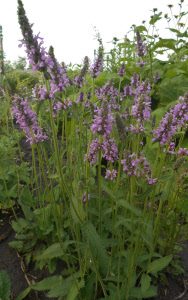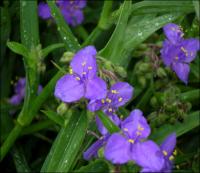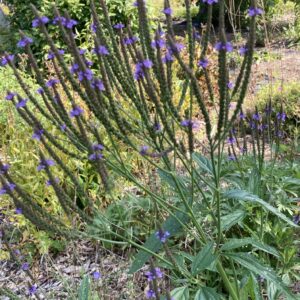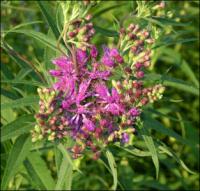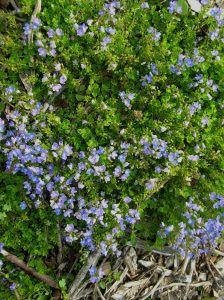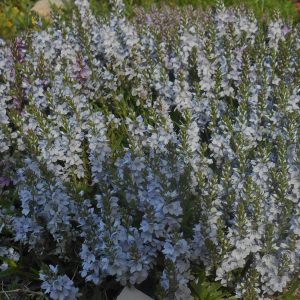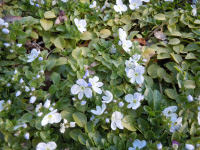Black Walnut Tolerant
Showing 97–104 of 106 results
-
Stachys officinalis syn. Betonica officinalis syn. Stachys betonica Bishop’s wort, Betony Z 4-8
Showy reddish-purple spikes of two-lipped tubes in May and June
Showy reddish-purple spikes of two-lipped tubes in May and June
Size: 18-24” x 12-18” slowly spreading
Care: sun in moist well-drained soil
Native: Europe and Asia
Wildlife Value: deer & walnut tolerant, attracts hummingbirdsOnce one of the most honored herbal medicines. Medicines were good if they had “as many virtues as Betony.” John Sauer, Colonial herbalist claimed “there is no illness brought on by cold in which Betony cannot be administered effectively.”
-
Tradescantia virginiana Spiderwort Z 4-9
Purple umbels of three petals with prominent yellow stamens June – October, opening in the morning and closing at noon.
Purple umbels of three petals with prominent yellow stamens June – October, opening in the morning and closing at noon.
Size: 18-24" x 24"
Care: Full sun to part shade in moist to moist well-drained soil
Native: From New York to South Dakota, Virginia and Arkansas and all states in between. Wisconsin native.
Wildlife Value: Bumblebees and honeybees eat the nectar and collect the pollen.Named after John Tradescant, an English botanist and gardener to Kings James III and Charles I. Parkinson (1567-1650) explains the origin of this plant: “This Spider-wort is of late knowledge, and for it the Christian world is indebted unto that painfull industrious searcher, and lover of all natures varieties, John Tradescant who first received it of a friend, that brought it out of Virginia,” (1639). It was probably sent to mainland Europe in 1500’s. Grown at America’s 1st botanic garden, Elgin Botanic Garden 1811. Tradescantia was cherished by the Dakota Indians for its beauty. Cherokee ate the young greens and prescribed it to cure stomachaches after overeating, female illnesses, cancer, and insect bites. Menominee revived those “defiled by touch of bereaved.” Natives applied a poltice of the leaves topically for insect bites and stings. By 1659 ones with white, light blue and reddish flowers grown in England. According to Monticello.org the root exuded a gummy liquid which, when inserted into a cut on top of a person’s head remedied the person’s “craziness.”
-
Verbena hastata Blue vervain, Simpler’s joy Z 3-9
Bright purplish-blue candelabra-like spikes from July to September
Bright purplish-blue candelabra-like spikes from July to September
Size: 2-4’ x 2’
Care: sun to part shade in moist or moist well-drained soil
Native: eastern 2/3rds of No. America, Wisconsin native
Wildlife Value: Cardinals & Sparrows eat the seeds. Food for larvae of Buckeye butterfly.Native Americans used plant as remedy for coughs, colds, and fever. Mahuna Indians of So. California used the root to cure complicated stomach fevers. Sioux fed the seeds to their horses to give them energy. The Sioux also used it as an insect repellant. Pressed specimen in Emily Dickinson’s herbarium.
-
Vernonia noveboracensis Ironweed Z 4-8
Heads of numerous deep, royal purple, platter-forming flower several feet high above in late summer
Heads of numerous deep, royal purple, platter-forming flower several feet high above in late summer
Size: 6-7' x 3'
Care: Sun in moist to moist well-drained soil
Native: Massachusetts to Florida
Wildlife Value: attracts butterfliesNamed for English botanist William Vernon. Infusions of the plant used by Cherokee to relieve pain after childbirth, for loose teeth and for stomach ulcers.
-
Veronica gentianoides Gentian speedwell Z. 4-9
Erect spikes of pale blue flowers sprouting above clumps of basal foliage in late spring/early summer.
Erect spikes of pale blue flowers sprouting above clumps of basal foliage in late spring/early summer.
Can not ship to: Illinois
Size: 18" x 12"
Care: sun to part shade in moist well-drained soil
Native: eastern Europe
Wildlife Value: attracts butterflies
Awards: England's Royal Horticultural Society Award of Merit.According to Christian tradition, as Jesus carried the cross to Calvary, a woman wiped his face with her handkerchief, leaving the imprint of the features of his face, the vera iconica, meaning “true likeness.” When the Catholic Church canonized the woman, the Church gave her the name Saint Veronica. Medieval gardeners named the plant after her due to the perceived likeness of the flower to her handkerchief. Introduced to European gardens by 1784.
-
Veronica liwanensis Turkish speedwell Z 4-8
Tiny true blue saucers smother the ground
OUT OF STOCK
Tiny true blue saucers smother the ground in May & June – groundcover, front of border or rock garden plant.
Size: 1” x 18” spreader over time
Care: sun to part shade in moist well-drained to well-drained soil
Native: NE Anatolia, Caucasus
Wildlife Value: attracts butterflies
Awards: 1997 Plant Select Winner.Collected before 1849.
-
Veronica prostrata syn. V. rupestris Sprawling speedwell, Harebell speedwelll Z 4-8
From midspring to midsummer short blue spikes above prostrate foliage.
OUT OF STOCK
From midspring to midsummer short blue spikes above prostrate foliage.
Size: 6” x 18”spreads
Care: sun to part shade in moist well-drained soil.
Native: Europe
Wildlife Value: Deer and rabbit resistant.
Awards: Royal Horticultural Society Award of Garden Merit.In gardens since at least 1753 (Linnaeus). Bloomed for 4 or more months in rock garden at Edinburgh Botanic Garden (The Garden, Jan. 1876.)
-
Veronica repens Creeping speedwell Z 5-9
Palest of blue blooms in spring
OUT OF STOCK
Palest of blue blooms in spring on this low, creeping groundcover.
Size: 2” x 8-12”
Care: full sun to part shade in moist to moist well-drained soil
Native: CorsicaAccording to Christian tradition, as Jesus carried the cross to Calvary a woman wiped his face with her handkerchief, leaving the imprint of Christ’s features, the vera iconica, meaning “the true likeness.” When the Catholic Church canonized the woman the Church named her Saint Veronica. Medieval gardeners named the plant after her due to a perceived likeness of the flower to her handkerchief. This species collected by 1800. According to William Robinson, father of the mixed perennial garden, Veronica repens “clothes the soil with a soft carpet of bright green foliage, covered in spring with pale bluish flowers.”

